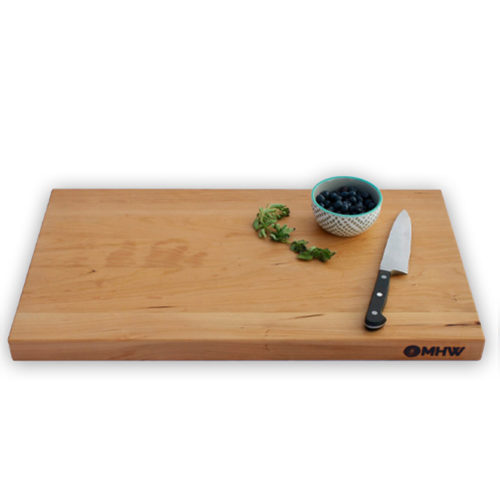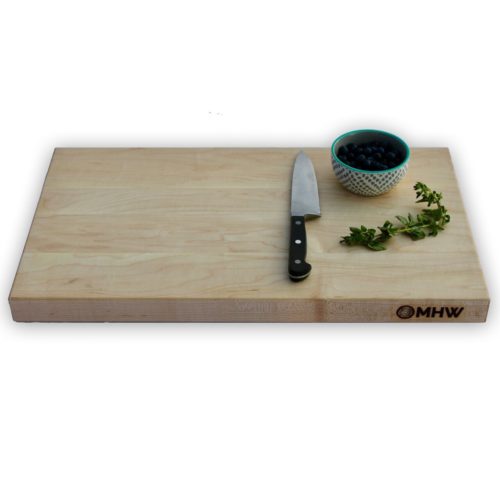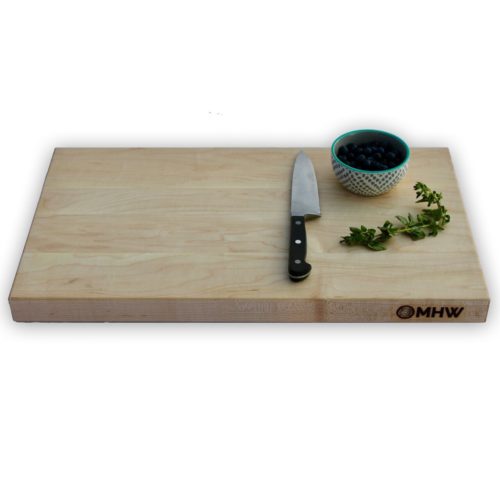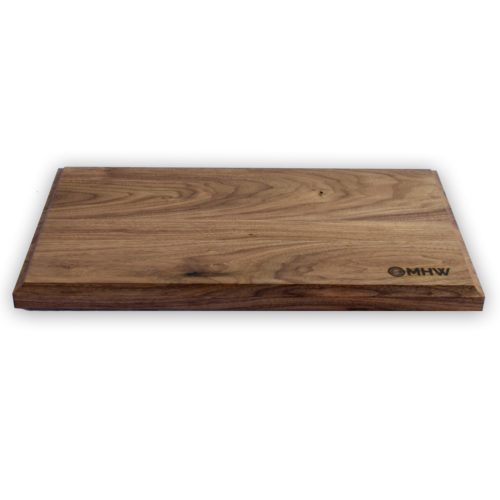Built Up to 2″ Thick | 30-Day Guarantee | Free Shipping
Our face grain cutting boards are hand-made and beautifully crafted using walnut, maple and cherry woods.
We provide a unique blend of custom cutting boards to match the feel of your kitchen and meet the demands of everyday cooking use. If you don’t see the right board for you, contact us for a quote on a custom build.
Wood Cutting Boards, Built for Longevity
For any cook in the kitchen, be it a beginner or master chef, it is important to know all the pros and cons of different types of cutting boards in order to safely and effectively slice and dice your next cuisine masterpiece.
What kind of advantages do wood cutting boards have over plastic cutting boards? Depending on the type of wood and grain, wood cutting boards will not scar easily, which prevents bacteria from growing, and they aren’t as rough on your knives as plastic cutting boards.
But there are pros and cons with all types of cutting boards. Most importantly, no matter what kind of cutting board you use, if it’s wood, plastic, bamboo, or hard rubber, if you’re not careful, you could be exposing yourself and your family to some serious illnesses.
Top Selling Products
Custom Cut Cutting Boards
When it comes to selecting the best wood cutting board, the two most important things to pay attention to are the grain and the type of wood. Both choices can significantly impact the number of bacteria absorbed by your board, as well as the impact the board has on your blades.
There are three types of grains used to make a wood cutting board: face grain, edge grain, or end (close) grain. The best choice is the end grain because the wood fibers are gentle on your knives and prevent scratches. These boards are easily identifiable because they look like checkerboards.
| Pros | Cons | |
| Face Grain | Attractive, affordable | Scratches easily, more prone to warping and bacteria |
| Edge Grain | Attractive, more durable than Face Grain | Still prone to scratches |
| End (close) Grain | Knife friendly, extremely durable, keeps bacteria away. | Expensive, requires more maintenance, heavy |
If a board is made from softwood, such as hickory or pine, the board will scratch easily when used. And bacteria love scratches and grooves.
If you’re looking for the home run combination, you’ll want to look for a wood cutting board that is both a hardwood and an end grain. To help keep bacteria at bay and to extend the life of your wood cutting board, apply mineral oil after each use.
This leads to some of the tradeoffs of wood cutting boards. If you purchase a quality wood cutting board, it will require maintenance like applying mineral oil. Plus, they are heavy, not dishwasher safe, and can be expensive.
Protect Your Investment
Our board butter is a great way to keep your butcher block in great condition for years; and is also 100% food-safe.

Cleaning And Sanitizing Your Cutting Board
No matter your choice, if you do your part to keep your board clean and maintained, you can prevent bacteria from lurking on your cutting board.
The Food and Drug Administration advises after each use of any cutting board that you wash the board all hot, soapy water, completely rinse the board, and then pat dry with a paper towel.
There may be a few more steps after washing and drying, depending on the type of cutting board:
| Cutting Board | After cleaning… |
| Wood cutting boards |
|
| Plastic cutting boards | 1. Sanitize with 1 tablespoon of bleach per 1 gallon of water. Or a more eco-friendly sanitizing option is to use one-part vinegar to three-parts water. |
| Hard rubber cutting boards | No additional maintenance required. |
| Bamboo cutting boards |
|
Learn What Customers Think of Our Cutting Boards
The Final Rules of Cutting Boards
Whatever type of board your heart desires, you should always follow what is known as the “two-board rule.”
To be absolutely certain to avoid any possible cross-contamination, designate one board just for raw meat, poultry, and fish, and another board for fruits, vegetables, or anything else that you can eat raw.
It’s a pretty simple rule to follow that many chefs, pros or amateurs, follow to ensure they don’t unintentionally bring illness to themselves or others. No matter how much you clean and care for your cutting board, you just never know what might be left behind.
Second, just to be safe, if there are significant signs of wear and tear, the board should be tossed out and replaced immediately. Bacteria just love making all those grooves and cuts their home, and no matter what you do, you’ll just never know if the board is completely clean.
A custom wood cutting board is a great addition to any kitchen. Picking the right one for you is important! Choose a wood that suits your needs and then maintain it.
View Our Engraving Gallery
Latest Blog Posts
Frequently Asked Questions
All of our cutting boards are designed and built using locally sourced wood from multiple suppliers in the area. We are based in Nampa, Idaho and are proud to deliver our products to customers across the nation.
12-15 days is our normal turn-around time during non-peak times of the year such as the holidays. Because your cutting board will be handmade, we are confident that waiting approximately 2 weeks will be well worth it.
We ship using both UPS and FedEx. Depending on the size of the board, as well as the shipping destination, this helps us determine the best option to get it to you the quickest. All of our boards are carefully wrapped and packaged to avoid damage during shipping.
Most cutting boards you find at stores are mass-produced, and most of them made in China. Our products are not only handmade in the USA, but our boards are built up to 2 inches in thickness, which means the durability level is unmatched when compared to other brands.
Yes we do. Our cutting boards and butcher blocks come with a 30-day money back guarantee. Click here to read more about this.
View this profile on Instagram
Get A Custom Quote
Do you need a cutting board custom built to a specific size and specs?














